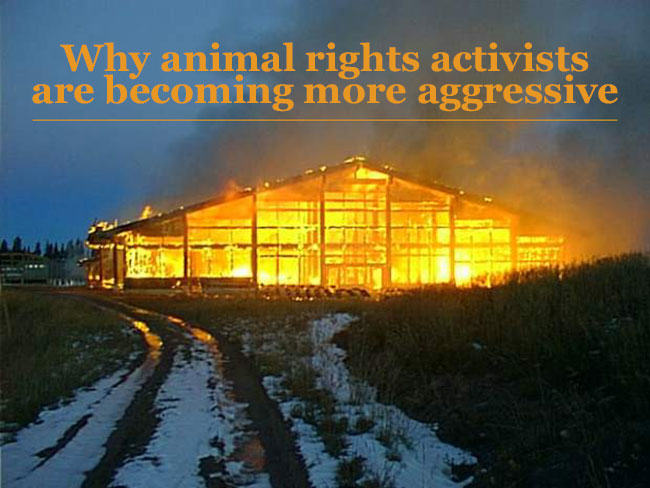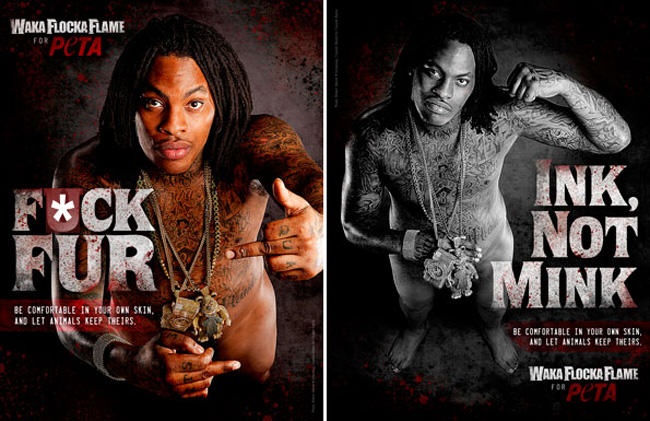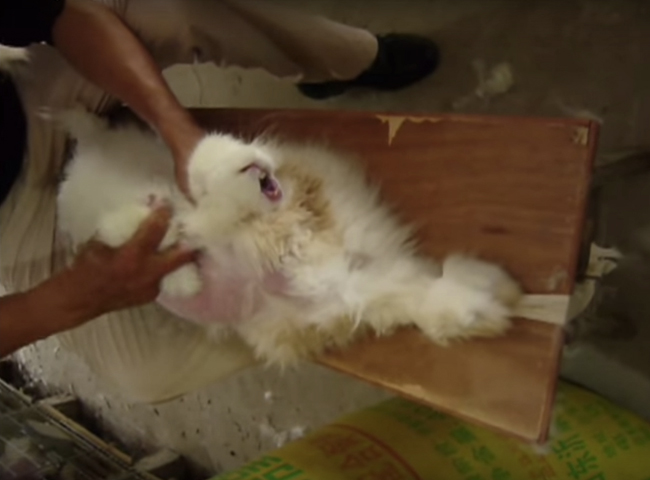
I received a phone call the other day from a very frightened fur retailer. Two young women had come into his store while he was serving a customer and begun lecturing him about the evils of selling fur. He had tried to stay cool and asked them to leave, several times, but they kept at him until, finally, he lost it and said things he wasn’t proud of. They had filmed him too; now his outburst was on an activist website and his Facebook page had been bombarded with comments accusing him of being a sexist thug.
“Am I finished?” he asked, shaken. “That’s not me, but they were so aggressive; honestly, I was frightened.” I told him to remove the threatening posts from his Facebook page – but to take screen-grabs first, for the record. I also advised him to make a police report about the women who had harassed him, and to ask the police to keep an eye on his store at night. (The windows of several fur stores in the same town were broken in the weeks that followed.)
Unfortunately, this is not an isolated incident. An outerwear store that sells fur-trimmed parkas in Vancouver has endured rowdy protests several times a week for more than a year. Activists now often follow fur-wearers down the street, haranguing them. DxE (“Direct Action Everywhere”) activists invade department stores, intimidating consumers and thumbing their noses at store security. At the opening of new Canada Goose stores in New York and Toronto, protesters carried “F*ck Canada Goose” posters. (So much for compassion and intelligent dialogue!) “Fur police” recently patrolled the streets of Hamburg, Germany, lecturing fur-wearers and giving them “tickets”.
READ ALSO: “Meat of the Matter: Peace-loving avengers,” by Dan Murphy, for Dairy Herd Management.
Fur is still a favorite target but any animal-based business can find itself under attack. An infuriating new tactic of animal rights activists is to blitz commercial Facebook pages with negative ratings and comments, as a Vancouver chef recently discovered when he added seal meat to his “sustainable and cultural foods” menu. (Ironically, activists often claim that the seal hunt is immoral because only the fur is used!)
Here are 5 reasons why animal rights activists are becoming more aggressive … and why it will likely get worse before it gets better.
1. Aggression Works
Activists have learned that many retail stores – even those of large corporations – have a low tolerance for confrontation. Things were different when most furs were sold by furriers running multi-generational family businesses; fur was what they knew, and they defended it with passion. With fur now popular for trim and fashion accessories, it is sold in a much wider range of stores.
This is putting fur on more people than ever before, but it also makes retailing more vulnerable: if fur represents only a small fraction of your sales but generates 99% of your security and PR problems, caving in to PETA is a tempting option. Unfortunately, the message to animal rights activists is that threats and intimidation work.

2. Pop Culture
If you have seen a music video recently — or follow much of what passes for political debate these days — you understand that the vulgar, arrogant and often aggressive tone of animal rights activists (“F*ck Fur!”) is very much in tune with certain elements of contemporary culture. And because there’s no sign of popular culture becoming much more polite any time soon, we can expect the arrogance and aggressiveness of these activists to intensify too.
3. Animal Rights Activists Are Getting Frustrated
Cleveland Amory, founder of the Fund for Animals, began campaigning against the fur trade in the late 1960s, almost 50 years ago. Protests intensified in the 1980s and then, again, with the emergence of media-savvy organizations like PETA. The traditional fur coat was also challenged by more casual lifestyles and the availability of less expensive winter clothing materials.
But just when it looked like Western consumers were abandoning their furs, the trade reinvented itself. Suddenly fur is everywhere, not only on 70% of designer runways, but in the streets – as trim on coats and parkas, on handbags, vests, scarves and boots. As trim and accessories, fur is more affordable and is being worn by more young people than ever.
Like old-time Stalinists frustrated with the “false consciousness” of workers who didn’t support The Revolution, many activists have concluded that, if moral persuasion isn’t working, it’s time for more vigorous methods. “As long as they do the right thing, we don’t really care why they’ve done it,” says PETA executive vice president Tracy Reiman when asked whether companies give up fur to avoid harassment, rather than because they share PETA’s views.

4. Social Media Encourage an Escalation of Emotion
Animal rights activists have always used disturbing images, but mainstream media rarely broadcast the most gruesome of them. In the Brave New World of social media, however, the gorier the better. As PETA’s Tracy Reiman says, “… we put out a video of rabbits that are having their fur ripped out, and everybody watches it.”
It is not hard to understand why normally compassionate people would be horrified by some of the images circulating on the Internet. If I thought these images really represented the fur trade, I would be against it too. So don’t be surprised that some idealistic young people decide it’s time to take stronger action to end such (apparent) atrocities.
The anonymity of social media also encourages more radical and polarized opinions, in all types of politics.
5. “Animal Rights” Is a Fundamentalist Ideology
The previous four points provide ample explanation for the more aggressive tone of animal rights activists. A more troubling question is whether the “animal-rights” philosophy itself may inevitably lead to more aggressive behaviour.
Despite all the media coverage of PETA’s antics, few people – journalists included – understand the profound chasm separating traditional “animal welfare” values from the radical and comparatively new “animal rights” doctrine. Animal welfare refers to our responsibility to minimize suffering for the animals we use. Hopefully everyone reading this post agrees with this. Animal rights, by contrast, says that humans have no right to kill or use animals at all, even for food or important medical research.
A more troubling question is whether the “animal-rights” philosophy itself may inevitably lead to more aggressive behaviour.
But if we truly believe that killing and eating an animal is the moral equivalent of murdering and eating another human being, then how far should we go to stop such “crimes”? Seen this way, activists who become more aggressive or even commit illegal acts are not “going too far”; rather, they are reading their animal-rights philosophers correctly.
“Animal rights” — like other fundamentalist doctrines — does not allow for respect or tolerance of differing views. In this sense, the increasing aggression of animal rights activists is not an accident or an aberration. But if intolerance and aggression are the logical conclusions of “animal rights”, maybe it’s time we took a much more critical look at this radical new philosophy. This will be the subject of a future article.











PETA have taken part in idiotic protests where one member wore this stupid rat costume with a sign RATS HAVE RIGHTS which shows just how far out into Stupidland they are Introduced Rats are a threat to the Birds native to various islands and they try to indocrinate kids with YOUR MOMMY KILLS ANIMALS,YOUR DADDY KILLS ANIMALS and LIFE OF A COW parents need to tell PETA to keep away from their kids.PETA was sued by a family after they took their little dog from t heir front yard and had it euthinised then they go around yammering all about COMPASSION and they have used the usial suckers from Hollywood like Pamela Anderson,Alec Baldwin and James Cromwell and we all know how Hollywood Liberals like to support silly liberal causes like Enviromentalism and Animal Rights
My father is a fur hater. No matter how much I explain to him the animal abuse u believe isn’t true,he just says “merchants do whatever they can for profits.”
How u should be treated is not bcs u’re sentient u feel good or bad about something,and blame others for it. It bigly depends on the situation and ur moral status.
U say kill a sentient being as u want is wrong I’ll agree with u.But,
[Kill and use a completely immoral being with little feeling of humanity in certain extend and rules] is morally ok.
When u think it’s good to be as little cruel as u can regardinglessly,u’re promoting another kind of mistreatment which’s also immoral.
How should I treat my father,I’ll probably just don’t talk about it again.
Unlike other “ideologies” sentient, family oriented, alive beings are being killed so they can be made into hats or hung on the wall or made into shoes. What part of “thou shalt not kill” did we decide to ignore? These are live beings with every right to live that any human has. Speaking of violent, hunters kill more people EVERY YEAR than animal rights activists do ever! The FBI now tracks animal abuse because it’s been PROVEN people who abuse and kill animals will abuse and kill humans. These animals are not sung quietly to sleep and the gently euthanized. They are electrocuted annually, beaten to death, hung, poisoned, skinned alive (the videos and reliable information are available on all this) and sometimes worse. It is naive to believe this is not a problem and ARAs are just angry activists. What is happening on this planet is genocide of sentient beings. The next time some one sticks an electric probe up your ass, or cuts your skin off while you are still breathing or poisons you so you loose your eyesight and your fur while you freeze to death in sub-zero weather before they get back to your cage to skin you or throw you in a pot if boiling water you tell me….should we try to stop them?
Devin, you make a passionate defense of the animal rights position, but while we would love to debate some of your points (e.g., that animals are skinned alive. This NEVER happens in the fur trade), you don’t address the point of this blog post. Do you agree that animal rights activists are becoming more aggressive, and if so, why do you think that is?
“Thou salt not kill” refers to innocent people, not animals. If you go reread Genesis. It is clearly stated that God bestowed all living things upon us to use
Stop it. Do you want to be taken seriously? Do some fact checking and leave emotions out of this. On another note, non-human sentient beings kill one another all the time. Often, it’s in ways far more brutal than what actually goes on in situations when humans kill animals.
Do you expect life to be some gentle and easy ride? Every being dies. Some leave in pain and others do not. You’re never going to prevent the painful deaths of millions of creatures every day. You’re never going to stop a pride of lions eating a Cape buffalo while it’s still alive. You’re sure as hell never going to stop a hunter from killing a rabbit, who probably did so in a way that didn’t cause it pain.
It’s not such a big thing that some special group of people thinks they need to come along and force their own delusional ideas about nature.
Grow up.
By the way, there is no inherent morality to any of it. Don’t think you can shame everyone into believing as you do. It’s annoying and says more about you than the person you’re tossing it at.
You are completly confusing everything, first of all people who torture and kill animals without a reason and for pleasure will kill humans, it isn’t as if someone who kills an animal for food will kill its pet or a human being.
2nd, Hunters hunt for food, skins, and the less important thing is keeping them as trophies, but nothing is wasted and their money is used for conservation.
And last, ufff, the information you gave about fur farms is fake.
Why are animal rights activists becoming so violent? because they are confused and they lack of true information, they don’t even know what an animal is.
AR’st Vegan Right-fighters generally lack any capability of Critical Thinking. They condemn fur and promote Oil Based Substitutes, then sign Anti Pipeline Petitions. In hypocrisy they paddled polyethylene Kayaks around the Oil Platform at Seattle Harbour destined for the Arctic. They destroy the livelihood of Arctic and Northern communities and then deny them opportunities of participating in the Industry that provides the Feedstock for most of their Alleged Cruelty Free Petroleum Based Fabric Substitutes.
It’s a case of the Blind Leading the Blind. Liberated poly-fleece fibres in the washing machine are flowing through Waste Water Treatment Plant discharge into the Oceans clogging the organs of Shellfish. Their Anti dogma includes the long fibres of Wool and Silk. Rayon a silk substitute like Bamboo fibre requires the Clearcutting of Forests evicting the forest critters they proclaim to defend. The Neurotoxin Carbon Disulphide poisons workers in the Pulp Mills and Fabric Plants.
Ref: https://www.seegerweiss.com/law-practices/toxic-exposure/Chemical-Exposure/Carbon-Disulfide/ Although the rubber, rayon, and cellophane industries have traditionally dominated the use of carbon disulfide, the toxin also has a history of use in agriculture as a grain fumigant, which was discontinued by the U.S. EPA in 1985. But this use has been dwarfed by a huge new application. A novel fumigant called metam sodium, which came to the market in the late 1980s. Carbon disulfide is metam sodium’s main starting ingredient. Metam sodium is used as a soil treatment against a variety of agricultural pests for a number of different crops.
Every time metam sodium is applied agriculturally, carbon disulfide is released into the air. More than fifty million pounds are used per year in the U.S.
When ( they ) get in my face that means they are in my ( space ) that means i have a right to defend myself.
If I was that store owner I would have quietly gone and locked the door, locking them inside, then called the police and had them hauled off in the paddy wagon. THAT is the answer to this behavior- JAIL TIME and court fines. When there are real consequences they won’t find it much fun anymore.
Locking them in side would constitute a false imprisonment charge against the shop owner.
In just saying. This is a catch 22 problem we are encountering.
Use caution!
It is starting to sound alto like domestic terrorist.
Call your local police and pres charges to the fullest extend of the law. Its time to start blowing their legal budget fund
I agree that animals should be treated humanely, even up until they’re about to slaughtered for consumption. I also think that endangered species need to be protected. That being said, Peta and other like minded people shoving their views down other people’s throats is bigoted and only hurts their own cause, creating a backlash against them. Perhaps that’s why they’re the minority. I like animals and I go on safaris a lot, but even I realize many of these animal rights activists go too far. Just because you don’t wear animal products doesn’t give you the right to try force others not to when an animal was treated well.
This bigotry is a growing liberal minded trend not only with animal rights but also with politics, look at Antifa and the growing backlash and rise of the right we’re seeing across the west.